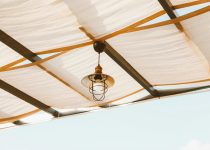What Materials Survive Heavy Outdoor Use?
When it comes to selecting materials for outdoor structures, durability is key. You need options that can withstand harsh weather and heavy use without showing signs of wear. From robust woods to innovative composites, the choices can be overwhelming. Each material has its own strengths and weaknesses, which can significantly impact your outdoor space's longevity. So, what should you consider to ensure your investment stands the test of time?
Table of Contents
Key Takeaways
- Cedar and redwood are naturally resistant to moisture and decay, making them ideal for outdoor use.
- Pressure-treated lumber protects against rot and insects, ensuring longevity in outdoor structures.
- Composite materials combine wood and plastic features, offering high durability and low maintenance for outdoor applications.
- Aluminum is lightweight and rust-proof, making it perfect for outdoor furniture and railings.
- Natural stone is durable, resistant to cracking, and requires minimal upkeep, suitable for patios and walkways.
Durable Wood Options for Outdoor Structures
When considering durable wood options for outdoor structures, it's essential to choose materials that can withstand the elements while maintaining their integrity.
Cedar and redwood are excellent choices, thanks to their natural oils that resist moisture and decay. If you're looking for something even more robust, pressure-treated lumber offers added protection against rot and insects, making it suitable for decks and fences.
Consider using hardwoods like teak or mahogany for furniture; they're incredibly dense and resistant to wear. Additionally, using wood with a proper sealant can enhance durability, preventing water damage and UV fading.
Always ensure you select sustainably sourced options to minimize environmental impact while enjoying your outdoor spaces for years to come.
Weather-Resistant Metals for Patios and Decks
Choosing weather-resistant metals for patios and decks can significantly enhance the longevity and aesthetics of your outdoor space.
These materials resist corrosion and wear, ensuring your investment lasts through the seasons. Here are some top options to consider:
- Aluminum: Lightweight and rust-proof, perfect for furniture and railings.
- Stainless Steel: Offers a sleek look and strong resistance to rust and staining.
- Galvanized Steel: Coated for extra protection against harsh weather.
- Bronze: Adds a classic touch with natural corrosion resistance.
- Copper: Beautiful patina over time, known for durability and resistance to the elements.
Composite Materials: The Best of Both Worlds
While traditional materials have their strengths, composite materials combine the best features of wood and plastic, making them an ideal choice for outdoor applications. They're engineered for durability, resisting fading, splintering, and moisture damage. This means you can enjoy your deck or patio without constant maintenance.
Here's a quick comparison of composite materials:
| Feature | Composite Materials | Traditional Wood |
|---|---|---|
| Durability | High | Moderate |
| Maintenance | Low | High |
| Resistance to Weather | Excellent | Poor to Moderate |
Thanks to their unique composition, you'll find composite materials not only look great but also stand up to the rigors of outdoor use, providing you with long-lasting beauty and functionality.
Natural Stone: Timeless Beauty and Strength
Natural stone offers a unique blend of timeless beauty and unmatched strength, making it a top choice for outdoor spaces.
You'll appreciate its durability, which withstands harsh weather and heavy foot traffic. Plus, each piece is distinct, adding character to your landscape.
Here are some benefits of using natural stone:
- Durability: Resistant to cracking and fading.
- Low Maintenance: Requires minimal upkeep compared to other materials.
- Aesthetically Pleasing: Complements a variety of design styles.
- Eco-Friendly: Sourced sustainably, reducing environmental impact.
- Versatility: Ideal for patios, walkways, and walls.
Innovative Synthetic Materials for Outdoor Use
When it comes to outdoor applications, innovative synthetic materials are revolutionizing the way you think about durability and design.
These materials, like high-density polyethylene (HDPE) and fiberglass, are engineered to withstand harsh weather and heavy use. You'll find that they resist UV damage, moisture, and extreme temperatures, making them ideal for everything from furniture to playgrounds.
Plus, they're often lighter and easier to work with than traditional materials. Many synthetic options also boast eco-friendly manufacturing processes, so you can feel good about your choices.
By incorporating these advanced materials into your outdoor projects, you're not just enhancing durability; you're also embracing modern aesthetics and functionality.
With the right selection, your outdoor space can be both beautiful and resilient.
Frequently Asked Questions
How Do I Maintain Outdoor Materials for Longevity?
To maintain outdoor materials for longevity, regularly clean surfaces, apply protective coatings, store items properly during harsh weather, and inspect for damage. Regular maintenance prevents deterioration and helps your outdoor materials last longer.
Are There Eco-Friendly Options for Outdoor Materials?
Yes, there are eco-friendly options for outdoor materials. You can consider bamboo, recycled plastics, or sustainably sourced wood. These choices not only reduce environmental impact but also provide durability and style for your outdoor spaces.
What Is the Cost Comparison of These Materials?
When comparing costs, consider both initial expenses and long-term durability. Some eco-friendly materials may seem pricier upfront, but their longevity can save you money over time. Don't forget to factor in maintenance costs too.
How Do Temperature Fluctuations Affect Outdoor Materials?
Temperature fluctuations can cause materials to expand and contract, leading to cracks or warping. You'll notice that some materials handle these changes better than others, so choose wisely to ensure longevity in outdoor conditions.
Can I Mix Different Materials for Outdoor Projects?
Yes, you can mix different materials for outdoor projects. Just ensure they're compatible in terms of durability and maintenance. Combining textures and colors can enhance aesthetic appeal while providing functional benefits. Experiment and find what works best!



